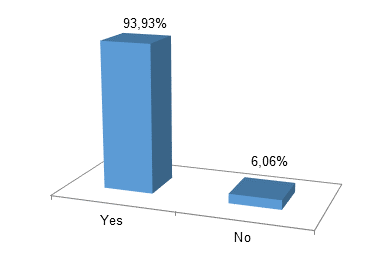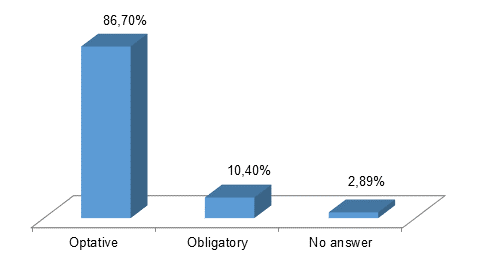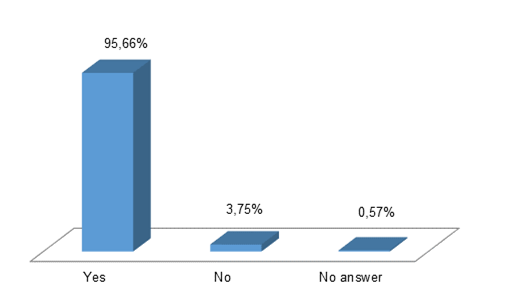My SciELO
Services on Demand
Journal
Article
Indicators
-
 Cited by SciELO
Cited by SciELO -
 Access statistics
Access statistics
Related links
-
 Cited by Google
Cited by Google -
 Similars in
SciELO
Similars in
SciELO -
 Similars in Google
Similars in Google
Share
Enfermería Global
On-line version ISSN 1695-6141
Enferm. glob. vol.18 n.55 Murcia Jul. 2019 Epub Oct 21, 2019
https://dx.doi.org/10.6018/eglobal.18.3.319551
Originals
Music therapy as a subject in grade studies in nursing
1Associate Professor of the Department of Plastic, Musical and Dynamic Expression of the University of Murcia. Murcia. Spain. norberto.lopez@um.es
2Academic Associate Professor at the Department of Nursing of the University of Murcia. Murcia. Spain.
3Full Professor of the Department of Animal Production of the University of Murcia. Murcia. Spain.
Introduction
Music therapy is understood by the use of music or its elements for therapeutic purposes. Its use in nursing is scarce beyond the use of the NIC 4400 intervention.
Objective
The research aims to know and analyze the degree of acceptance by nursing students regarding the possible inclusion of music therapy as a subject in the educational programs of the Nursing Degree studies.
Method
A cross-sectional, observational, descriptive study was carried out with a sample of n=346 participants.
Conclusion
The results show that 93.93% of the students did include music therapy as an optional subject in Nursing Degree studies, making use of it in their professional future.
Key words: Music Therapy; Nursing; Nursing Degree
INTRODUCTION
TheWord Federationof Music Therapy1(WFMT) defines the Music Therapy as the use of the music and its musical elements carried out by a Music Therapist who is qualified with a patient or group in a process created for facilitating and promoting the communication, the relationships, learning, the movement, the expression, the organisation, and other relevant therapeutic objectives to satisfy the physical, emotional, mental, social and cognitive needs.
In the definition which is proposed by the WFMT about Music Therapy, it is exposed explicitly the need of being a qualified professional in the subject to be able to care a patient. In relation to that, the music therapy keeps a close relationship with the nursing. This is the science which is in charge of preparing and forming future professionals to be ready for a patient´s care and needs, even with the usage of the music. According to Yáñez Amorós2,Florence Nightingale, considered as the foundress of the Modern Nursing, highlights the beneficial qualitiesof the music, which was used for giving care to the soldiers during Crimea War. In her workNotas de Enfermeríadescribes how the nurses used the voice and the flutes to provoke beneficial effects and to appease the soldiers´ pain.
Continuing in this area, the NursingInterventionsClassification, NIC,includes the Music Therapy in the intervention number 4400. Inside it, it is defined as “the use of the music to help to obtain a specific change of conducts, feelings or physiologic”3. In this connection, the Music Therapy could have a relevant role inside cares and interventions carried out by the nursing professionals.
Currently, the realised studies and investigations about Music Therapy from nursing perspectives and related to diverse pathologies or collectives are incipient. Some remarked studies are “La música como intervención de Enfermería en el ámbito oncológico” realised by Espinosa Torres y Ruiz Carreño4 and “Musicoterapia en el ámbito hospitalario: intervención en los cuidados enfermeros en anestesia, reanimación y dolor” made by Sabbatella Riccardi and Trujillo González5. That shows that nursing and Music Therapy can contribute together from the investigation to open new techniques and interventional ways which are unexplored in pursuit of wellness and the improvement of the quality of cares to the patients.
The Music Therapy is considered as a no pharmacologic treatment complementary or alternative to the hegemonic medical treatment. In the majority of the realised cases by nurses or medical staff who is no prepared for this issue. In this regard, our investigation had the finality of knowing and analysing the degree of acceptation of the Nursing students to the possible inclusion of the Music Therapy as a subject in the educative programmes of the Degree of Nursing.
OBJECTIVES
The present work pretends to know and analyse the acceptation grade of the nursing students of the University of Murcia to the possible inclusion of the Music Therapy as a subject in the educative programs in the studies of Nursing. This will have the finality of elaborating proposals to improve the academic and professional interests of the learners.
METHODOLOGY
A cross-sectional descriptive study has been realised. The population of the study has been the learners of the second and third courses of the Nursing Degree in the University of Murcia during the academic year 2016/2017 with a sample of 346 students. After receiving an introductive lesson of 2 hours and a half about Music Therapy, this was explicative and practical,a digital questionnaire of design and own elaboration was carried out that includes an initial part where the sociodemographic variables are collected: age, sex and academic year; and a second part, where there are three dichotomous closed questions of the questionnaire related to the inclusion of music therapy in nursing studies. The statistical analyses were carried out with the statistical package Statistical Package for the Social Sciences (SPSS) for Windows version 23. In the analysis of the data, the descriptive study of the variables was carried out using the arithmetic mean.
RESULTS
The sample was composed of 43,93% (n=152) of students in the second year and 56.06% (n=194) of students in the third year being the feminine sex the most predominant (81.55%).
In the Table 1, we can observe in both courses a predominance of women in relation to the sex of the students being 81.50% of the total sample analysed.
Regarding the inclusion of Music Therapy as a possible subject in Nursing Degree studies, we can see in Figure 1 that 93.93% of students agree positively that music therapy must be present in the aforementioned studies.
In relation to the type of subject that should be, 86.70% opts for an optional subject versus 10.40% that opts for a compulsory subject. 2.89% does not respond. (Figure 2).
When asked if they would use Music Therapy in their professional activity, more than 95% of students would use Music Therapy in their respective jobs as future nurses if they had the chance, compared to 3.75% who did not. 0.57% does not answer. (Figure 3).
DISCUSSION
The positive propensity of the students to accept Music Therapy as an integral part of the academic curriculum of nursing studies, as well as their predisposition to use it in their professional future, shows that the use of music therapy from a perspective nurse opens new professional horizons. The studies carried out by Lin, et al.6 show that music therapy can be used as an innovative academic resource to improve the motivation of nursing students to learn and approach older people, in order to expand their professional field towards the gerontological nursing.
Studies carried out by Camacho, et al.7 demonstrate the need to adapt the educational plans in the Nursing Degree in terms of the reorientation and extension of certain subjects, such as the case of training in English for nurses, so that the needs, motivations and academic demands of the students are achieved in order to reach the level of mastery required to successfully complete their degree studies. In this sense, as proposed Camacho7, Johanessen and Garvik8 or Ing-Randolph9, the reorientation of educational plans to enable the inclusion of music therapy as a discipline to study within the Degree in Nursing would allow the creation of new competence profiles for the students, allowing to expand their professional training for an increasingly demanding and specialized labor market.
Palmer, et al.10through their study highlights the positive collaborationin the relationship between nurses and music therapists. It proposes that music therapy can help to improve patient outcomes, alleviate the workload of nurses and serve as a pleasant complementary therapeutic modality for both patients and members of the health staff. Research such as Palmer´s or Detmer´s and Whelan´s11 show that music therapy can be a further degree of specialization within nursing, allowing the nurse to provide optimal patient care.
The present study has some limitations. The size of the sample could have been extended to include all the students that make up the four courses of the degree, as well as having it extended to other regional centers where the same studies are taught. The data collected are restrictive due to closed responses. This limitation could be corrected by conducting interviews to obtain qualitative data and deepen the reasons for the choice of answers.
REFERENCIAS
1. About WFMT. Disponible en: http://www.wfmt.info/wfmt-new-home/about-wfmt/ [ Links ]
2. Yáñez Amorós B. Musicoterapia en el paciente oncológico. Cultura de los Cuidados [Internet]. 2011; (29):57-73.[Consultado 8 de julio 2017] Disponible:http://rua.ua.es/dspace/bitstream/10045/17454/1/Cultura_Cuidados_29_07.pdf [ Links ]
3. Bulechek GM, Butcher HK, McCloske y Dochterman J. Clasificación de Intervenciones de Enfermería (NIC). 5ª ed. Barcelona: Elsevier España, S.L; 2009. p. 639. [ Links ]
4. Espinosa Torres Andrea, Ruiz Carreño Paula. La música como intervención de Enfermería en el ámbito oncológico. Rev Paraninfo Digital, 2015; 22.[Consultado 8 de agosto 2017] Disponible en: http://www.index-f.com/para/n22/314.php [ Links ]
5. Sabbatella Riccardi, Patricia Leonor, Trujillo González, Alicia. Musicoterapia en el ámbito hospitalario: intervención en los cuidados enfermeros en anestesia, reanimación y dolor. Enferm Anest, 2009; (17): 18-21. [Consultado 8 de agosto 2017] Disponible en:http://www.academia.edu/1886258/Musicoterapia_en_el_%C3%81mbito_Hospitalario_Intervenci%C3%B3n_en_los_Cuidados_Enfermeros_en_Anestesia_Reanimaci%C3%B3n_y_Dolor [ Links ]
6. Lin HC, Chen SL, Hsieh CE, Lin PY. Music Therapy Training for Undergraduate Nursing Students: A Modality to Foster Interest in Gerontological Nursing. Journal of Gerontological Nursing, 2016. 42(6), 25-31. [Consultado 9 de agosto 2017] Disponible en: https://www.healio.com/nursing/journals/jgn/2016-6-42-6/%7B5bbf1f09-8825-45c3-8eec-ca8f7d76bf2f%7D/music-therapy-training-for-undergraduate-nursing-students-a-modality-to-foster-interest-in-gerontological-nursing [ Links ]
7. Camacho Bejarano R., Barquero González A., Mariscal Crespo MI., Merino Navarro D. Motivación, necesidades y expectativas de los estudiantes del Grado en Enfermería en el aprendizaje del inglés como segunda lengua. Index Enferm (Gran) 2012; 21 (4): 194-198. [ Links ]
8. Johanessen B, Gravik G. Experiences with the use of complementary and alternative medicine in nursing homes: A focus group study. Complement TherClinPract. 2016 May;23:136-40.[Consultado 9 de agosto 2017] Disponible en: https://www.ncbi.nlm.nih.gov/pubmed/25958118 [ Links ]
9. Ing-Randalph AR, Phillips LR ,Williams AB. Group music interventions for dementia-associated anxiety: A systematic review. Int J Nurs Stud. 2015 Nov;52(11):1775-84. [Consultado 9 de agosto 2017] Disponible en: https://www.ncbi.nlm.nih.gov/pubmed/26228591 [ Links ]
10. Palmer JB, Lane D, Mayo D. Collaborating With Music Therapists to Improve Patient Care. Aorn Journal. 2016 Sep; 104(3):192-7. [Consultado 9 de agosto 2017] Disponible en: https://www.ncbi.nlm.nih.gov/pubmed/27568531 [ Links ]
11. Detmer MR, Whelan ML. Music in the NICU: The Role of Nurses in Neuroprotection. Neonatal Netw. 2017 Jul 1;36(4):213-217. [Consultado 9 de agosto 2017] Disponible en: https://www.ncbi.nlm.nih.gov/pubmed/28764824 [ Links ]
Received: January 25, 2018; Accepted: June 05, 2018











 text in
text in 






